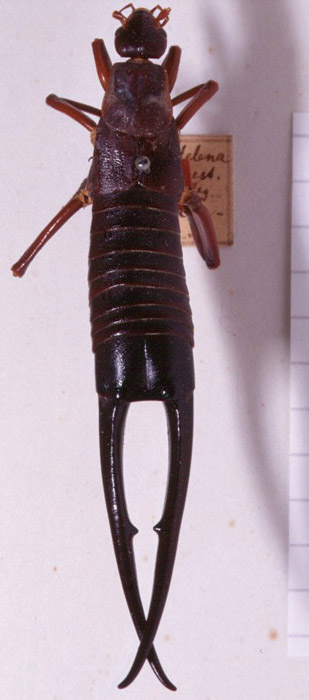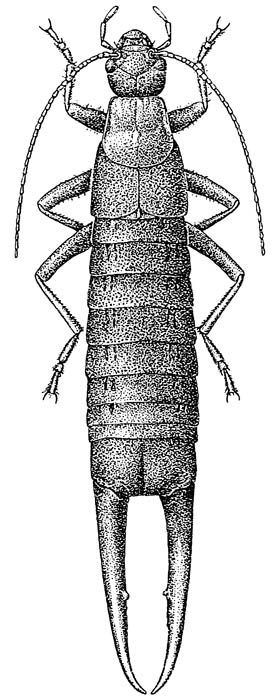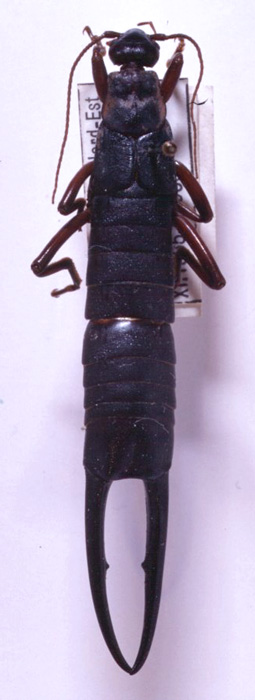


Type specimen of JC Fabricius in Copenhagen. Distance between lines 5 mm, body length 80 mm.
© ZMUC, Copenhagen
Not to scale.
Drawing from Brindle, 1970 (page 223, fig 22)
Not to scale.
© NHM, London
Labidura herculeana (Fabricius, 1798), a real giant with up to 80 mm body length, is sometimes called the "Dodo" of the Dermaptera. This is because, much like the Dodo, this endemic species lived on a very confined area on a small area on a small island in the Atlantic Ocean, St. Helena. You could not find it anywhere else on the world.
Labidura herculeana (Fabricius, 1798), called St. Helena Striped Earwig, Giant Earwig or St. Helena Giant Earwig, was first described in by the Danish Entomologist Fabricius in 1798, and then it was forgotten - earwigs have never received too much attraction. The next specimens was collected by Babault in 1913 (specimen now in MNHN) and according to the Wikipedia page, were found by Douglas Dorward and Philip Ashmole with bird bones at Prosperous Bay in 1959. Published records are found in Brindle (1970). He himself was not on the island but the specimens where found by Dr. Leleup who was the driving force of an expedition of the RMAC to the island, conducting a survey of the fauna of this island (Leleup 1970). A four volume book originated from this research, describing not only the biodiversity of St. Helena (St. Helene in French) but gives also information on geology, climate etc.
With the increasing interest in nature, conservation and the special characters of island fauna (e.g. "How did all the animal got there when the island was never connected to the mainland?" etc.) scientists tried to find it again. Two expeditions were conducted by Paul Pearce-Kelly from the London Zoo in 1988 and 1993, however, they failed to find any trace of this large species; also Howard Mendel failed to find any trace in 2006 (pers. comm.).
Naturally, sometimes you miss species even if you are looking for them. However, this species is very large and so are the nymphs which live in the same habitat. In addition, there are reports that you can sometimes find the very well sclerotised cerci as (sub-)fossils (Zeuner 1962). This seems to have been the case in 1995 (Ashmole & Ashmole 2004) but these authors were unable to find specimens in 2000 and 2003 (Ashmole & Ashmole 2004). Alas, neither nymphs nor fossil cerci where found in recent years.
According to Ashmole & Ashmole (2000), Labidura herculeana (Fabricius, 1798) could be extinct due to the clearing of the Gumwood forest where the species lived (in the area of Horse Point), another cause of the alleged extinction could have been the competition with the introduced centipede Scolopendra morsitans.
As it seems, it is now extinct, at least there was no sighting for a considerable time and there for it is categorie 'CR B1+2a' in the IUCN Red Lists.
The Wikipedia page on the Giant Earwig holds additional interesting information and images.
 |
 |
 |
| Labidura herculeana (Fabricius, 1798). Type specimen of JC Fabricius in Copenhagen. Distance between lines 5 mm, body length 80 mm. © ZMUC, Copenhagen |
Labidura herculeana (Fabricius, 1798). Not to scale. Drawing from Brindle, 1970 (page 223, fig 22) |
Labidura herculeana (Fabricius, 1798). Not to scale. © NHM, London |
| More images on next page ... |
The Giant Earwig is a Labiduridae and clearly belongs to the genus Labidura Leach, 1815. A phylogeny of the genus Labidura was never worked out, however, it has great morphological similarity to the well known Giant, Tawny or Striped earwig, Labidura riparia (Pallas, 1773). The latter species attained world wide distribution without human interference (unlike the European or Common Earwig, Forficula auricularia Linnaeus, 1758, which is syn-anthropic). Labidura riparia (Pallas, 1773) occurs on all continents (except Antarctica), and its rafting and floating survival is so good that it reached many isolated islands.
So, it seems plausible to me that Labidura herculeana originated from stranded Labidura riparia (Pallas, 1773), with its own specialisation for a very limited habitat. L. herculeana (Fabricius, 1798) and L. riparia (Pallas, 1773), both were found on St. Helena, did not share same habitat and L. herculeana (Fabricius, 1798) never distributed beyond St. Helena.
Of course, no physiological studies were done with Labidura herculeana (Fabricius, 1798). However, if the outlined relationships are true, then most of the data, and there are a lot, on the behaviour, maternal care and physiology from Labidura riparia (Pallas, 1773) can be applied to Labidura herculeana (Fabricius, 1798). Albouy & Caussanel (1990) summarised the available data.
In my view, one of the most notable bahaviours of Dermaptera is maternal care. The female is regularly cleaning the egg, since they would fall prey to fungi, and defends them against predators. This behaviour is extended to the first and second instar nymphs. So, females of Labidura herculeana (Fabricius, 1798) were certainly good mothers.
Following species were recorded from St. Helena My source is mainly Brindle (1970):
Anisolabididae: Carcinophorinae: Anisolabis maritima (Bonelli,1832). Cosmopolitan.
Anisolabididae: Carcinophorinae: Euborellia annulipes (Lucas, 1847). Cosmopolitan.
Labiduridae: Labidurinae: Labidura herculeana (Fabricius, 1798). Endemic, extinct.
Labiduridae: Labidurinae: Labidura riparia (Pallas, 1773). Cosmopolitan.
"1/II/1967, (on the road to Horse Tail) "la ferme de Longwood. Le contre maître nous ayant déconseillé de faire monter de la main d'oevre, aujourdhui a eau de pluie insistante, ..., Jeanne, Jean et moi trouvent chacun deux Labidura géantes (Jean 1male et une femelle), moi 2 mâles, dont 1 ... 68 mm de longeur et dont les cerques atteignent 24 mm."
Notes contributed by Hans Henderickx.
IUCN Redlist and specific page
Wikipedia on the St. Helena Earwig
Wikipedia on Earwigs in German and in English
Stamps with the Giant Earwig and other species Page 1, Page 2, Page 3
St Helena and Ascension Island Natural History
The Sunday Independent, South Africa, of 27 November 2005, on the Giant Earwig: "It's giant earwigs versus aircraft on remote St Helena"
Forum News 24: "St. Helena’s endemic invertebrates – forty years on" page 9. (PDF download, 1.5 MB)
See also "Biodiversity: the UK Overseas Territories" Report by the Joint Nature Conservation Committee (PDF download, 60 KB)
Albouy V, Caussanel C (1990) Dermaptères ou Perce-oreilles [Dermaptera or earwigs]. Faune de France, 75: 245 pp. Basically a French Dermaptera Fauna but with extensive general biology section. Good introduction to all aspects of Dermaptera biology. In French.
Ashmole P, Ashmole M (2000) St. Helena and Ascension Island: a natural history. Nelson, Oswestry, 492 pp.
Ashmole P, Ashmole M (2004) The invertebrates of Prosperous Bay Plain, St Helena A survey by Philip and Myrtle Ashmole, September – December 2003. Commissioned by the St Helena Government and financed by the Foreign and Commonwealth Office. (Word download).
Brindle A (1970) Dermaptera. La faune terrestre de l'île de Sainte-Helene, Annales du Musee Royal de l'Afrique Centrale Tervuren, Series no 8, Sciences Zoologiques 1: 213-227. Major publication on this species.
Brindle A (1981) The types of Dermaptera described by Fabricius. Entomologist's Record and Journal of Variation, 93 (1): 14-16.
Burr M (1911) Dermaptera. Genera Insectorum, 122: 112 pp.
Fabricius JC (1798) Supplementum entomologiae systematicae. - pp. [1-3], 1-572. Hafniae. (Proft & Storch). Original Description. Download the original description (PDF download) found on AnimalBase.
Leleup N (1970) La faune terrestre de l‘ile de Sainte-Helene (Première partie). 1. - Geographie et Climatologie. Annales du Musee Royal de l'Afrique Centrale Tervuren, Series no 8, Sciences Zoologiques, 181: 8-73.
Steinmann H (1989) Dermaptera: Catadermaptera II. Das Tierreich, 105: 505 pp. Keys for all Labiduridae (and Labidura).
Zeuner FE (1962) A subfossil giant Dermapteron from St. Helena. Proceedings of the Zoological Society of London, 138: 651-653. description of a fossil which was later synonymised with Labidura herculeana (Fabricius, 1798).